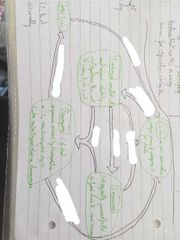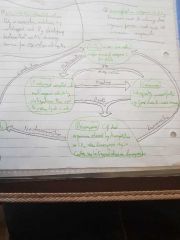![]()
![]()
![]()
Use LEFT and RIGHT arrow keys to navigate between flashcards;
Use UP and DOWN arrow keys to flip the card;
H to show hint;
A reads text to speech;
41 Cards in this Set
- Front
- Back
|
Ecology |
Study of relationships between organisms and their environment |
|
|
Ecosystem |
All populations of different species at the same time interacting with abiotic and biotic factors |
|
|
Abiotic factors + e.g |
Non-living physical factors Temperature light water edaphic factors |
|
|
Biotic factors |
Living factors for example competition intraspecific and interspecific |
|
|
Temperature |
enzymes denature at high temperatures Ectotherms and plants like warm environments |
|
|
Light |
Low levels of the light cause plants with big leaves |
|
|
Water availability |
causes water stress causing intraspecific and interspecific competition and plants adapt to different conditions e.g. hydrophytes |
|
|
Trophic level |
Position of an organism in the food web |
|
|
Producer |
Convert light energy into chemical energy by photosynthesis autotrophs |
|
|
Consumer |
obtain energy by feeding on other organisms heterotrophically |
|
|
Why food chains rarely have more than 4 trophic levels |
There is not sufficient biomass and stored energy to support further organisms due to the 10% rule |
|
|
Pyramid of number disadvantages |
Can be inverted and can be misleading |
|
|
Pyramid of biomass |
Biomass x number Must discount water mass and measure only the parts of the organism that are eaten |
|
|
Energy producers convert into biomass |
1 to 3% |
|
|
Reasons for producer energy loss |
90% of light reflected as it is a certain wavelengths Water availability limits photosynthesis Proportion of energy lost due to other reactions like respiration |
|
|
Net production equation |
Gross production - respiratory losses |
|
|
Ecological efficiency equation |
Biomass after transfer over biomass before transfer x 100 |
|
|
How to reduce energy loss in agriculture |
Greenhouses with warmth light water and carbon dioxide Pesticides and herbicides Reduction of space to reduce movement and heat losses Antibiotics to reduce infection Culling to reduce competition |
|
|
Reasons why consumers convert 10% into biomass |
Some of organism is indigestible Some of organism is not eaten Heat losses to environment Respiration Excretion |
|
|
Decomposition |
Breakdown of a compound into smaller molecules so it can be utilised by other organisms |
|
|
Decomposers |
Organisms feeding on and breaking down dead plant or animal matter from organic to inorganic compounds Digest using enzymes secreted externally and are saprotrophs |
|
|
Denitrivores |
Speed up Decay process by breaking down denitris or dead material into smaller pieces with a larger surface area so decomposers can work quicker Digest internally |
|
|
Nitrogen fixation |
N2 to NH3 Nitrogen fixing bacteria contain enzyme nitrogenase which combines nitrogen and hydrogen to form ammonia |
|
|
Nitrogen fixation bacteria |
Aztobacter, free living Rhizobium, legumes root nodules |
|
|
Nitrogen fixation symbiotic relationship |
Rhizobium gives plants amino acids and bacteria gain carbs that the plant produces |
|
|
Nitrification |
NH3 to NO2- to NO3-
1 ammonia oxidised into nitrites using nitrifying bacteria's e.g. nitrosomas 2 nitrites oxidized to nitrates using nitrobacter Nitrates highly soluble so plants can uptake |
|
|
Denitrification |
No3 - goes to N2 Only in anaerobic conditions e.g. waterlogged soil Denitrifying bacteria use nitrates as energy source for respiration releasing nitrogen gas |
|
|
Ammonification |
Decomposers convert nitrogen containing dead organisms faeces and urine into ammonium compounds |
|
|
Nitrogen cycle bacteria |
Nitrification = nitrosomas then nitrobacter Nitrogen fixation = aztobacter and rhizobium |
|

Carbon cycle |

|
|
|
Carbon dioxide fluctuations |
More CO2 in night and less in day due to photosynthesis and localised CO2 levels fluctuate seasonally also due to photosynthesis |
|
|
Primary succession |
Newly formed or exposed land where there is no initial organic material EG glacier retreat Slow |
|
|
Secondary succession |
There is soil but it has no plant or animal species e.g. after a forest fire Fast |
|
|
Step of succession |
Seral stage |
|
|
Order of stages succession |
Pioneer to intermediate to climax |
|
|
Pioneer community |
Uncolonised area colonized by Pioneer species which modify environment They have several adaptations such as Produce many spores and seeds photosynthesize can tolerate extreme conditions can fix nitrogen |
|
|
Intermediate community |
Weathering of bare rock produces soil Decomposition of Pioneer species releases organic hummus Contains minerals to support secondary colonizers for example mosses Pioneers maybe a food source Tertiary colonizers for example phones may also arrive, these have a waxy cuticle to protect against water loss |
|
|
Climax community |
Stability and less hostile environment Dominant species mean biodiversity may be low due to their success Little change and hostility |
|
|
Animal succession |
Usually slower as areas are isolated and food sources may not be established |
|
|
Deflected succession |
Succession stopped by human activity forming a plagioclimax Often due to agriculture such as grazing removing shrub land or deforestation |
|
|
Global warming reasoning and evidence |
More combustion and more deforestation means more carbon dioxide This traps more thermal energy in atmosphere Also means oceans can store less carbon dioxide Changes determined by probing Deep glaciers where air bubbles trapped millions of years ago and comparing this to current oceans |

